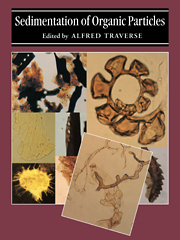Book contents
- Frontmatter
- Contents
- Editor's preface
- List of contributors
- I Introduction
- II Studies of palynosedimentation in modern environments
- III Reconstruction of late Cenozoic vegetation and sedimentary environments from palynological data
- IV Application of data on palynosedimentation to solution of geological problems
- 16 Palynology of sedimentary cycles
- 17 Particulate organic matter, maceral facies models, and applications to sequence stratigraphy
- 18 Association of palynomorphs and palynodebris with depositional environments: quantitative approaches
- 19 A quantitative approach to Triassic palynology: the Lettenkeuper of the Germanic Basin as an example
- 20 Palynomorph concentration in studies of Paleogene nonmarine depositional environments of Wyoming
- 21 Multivariate analyses of palynomorph data as a key to depositional environments of Upper Cretaceous and Paleogene coal-bearing rocks of the western United States
- 22 Relationships between depositional environments and changes in palynofloras across the K/T boundary interval
- 23 Sedimentation of palynomorphs in rocks of pre-Devonian age
- V Appendix
- Index
22 - Relationships between depositional environments and changes in palynofloras across the K/T boundary interval
Published online by Cambridge University Press: 06 January 2010
- Frontmatter
- Contents
- Editor's preface
- List of contributors
- I Introduction
- II Studies of palynosedimentation in modern environments
- III Reconstruction of late Cenozoic vegetation and sedimentary environments from palynological data
- IV Application of data on palynosedimentation to solution of geological problems
- 16 Palynology of sedimentary cycles
- 17 Particulate organic matter, maceral facies models, and applications to sequence stratigraphy
- 18 Association of palynomorphs and palynodebris with depositional environments: quantitative approaches
- 19 A quantitative approach to Triassic palynology: the Lettenkeuper of the Germanic Basin as an example
- 20 Palynomorph concentration in studies of Paleogene nonmarine depositional environments of Wyoming
- 21 Multivariate analyses of palynomorph data as a key to depositional environments of Upper Cretaceous and Paleogene coal-bearing rocks of the western United States
- 22 Relationships between depositional environments and changes in palynofloras across the K/T boundary interval
- 23 Sedimentation of palynomorphs in rocks of pre-Devonian age
- V Appendix
- Index
Summary
Introduction
Interest in understanding the reaction of plant communities to the Cretaceous-Tertiary (K/T) boundary event has focused increased attention on late Maastrichtian and Early Paleocene palynofloras. Both the relative abundances of major groups of palynomorphs and range truncations have been used to infer changes in terrestrial environments coincident with the K/T boundary in mid-continental North America (Orth et al., 1981; Tschudy et al., 1984; Nichols et al., 1986; Bohor et al., 1987; Lerbekmo et al., 1987; Fleming & Nichols, 1990; Nichols, 1990; Sweet et al., 1990; Nichols & Fleming, 1991; Sweet & Braman, 1992). These criteria sometimes are used to emphasize the more catastrophic aspects of floral change at the K/T boundary (Orth et al., 1981; Tschudy et al., 1984; Nichols et al., 1986; Bohor et al., 1987; Fleming & Nichols, 1990). In other publications the relative abundance spikes and range truncations are considered to be part of a continuum of change across the boundary (Tschudy & Tschudy, 1986; Lerbekmo et al., 1987; Sweet et al., 1990; Sweet & Braman, 1992). It now is generally accepted that many morphologically complex species of angiosperm pollen became extinct at or within an interval immediately contiguous to the K/T boundary, and that there is a causal connection between these extinctions and the K/T event.
The dominant late Maastrichtian miospore species often represent flowering plants (Tschudy & Tschudy, 1986; Lerbekmo et al., 1987; Sweet et al., 1990). A dramatic shift occurs in the relative abundances of spores and pollen immediately after the K/T extinction event in most North American terrestrial sections.
Information
- Type
- Chapter
- Information
- Sedimentation of Organic Particles , pp. 461 - 488Publisher: Cambridge University PressPrint publication year: 1994
Accessibility standard: Unknown
Why this information is here
This section outlines the accessibility features of this content - including support for screen readers, full keyboard navigation and high-contrast display options. This may not be relevant for you.Accessibility Information
- 5
- Cited by
